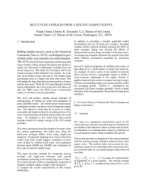
An official website of the United States government
Here’s how you know
Official websites use .gov
A .gov website belongs to an official government organization in the United States.
Secure .gov websites use HTTPS
A lock (
) or https:// means you’ve safely connected to the .gov website. Share sensitive information only on official, secure websites.
-
//
- Census.gov /
- Library /
- Census Working Papers /
- Multi-Year Averages From A Rolling Sample Survey
Multi-Year Averages From A Rolling Sample Survey
Multi-Year Averages From A Rolling Sample Survey
Introduction
Rolling sample surveys, such as the American Community Survey (ACS), are designed to give reliable multi-year estimates for small domains. The ACS collects the basic population and housing data using monthly rolling samples throughout the decade to update the information traditionally available from the census long form. The basic ACS estimates will be the annual averages of data obtained every month. As in the case of decennial census, this survey will sample small government units at a higher rate than other areas. This will update the long form data on characteristics of areas smaller than states. With the ACS providing the detailed annual information, the census long form will phase out after the 2000 census, the 2010 census concentrating mainly on the basic count of population.
The ACS will produce reliable annual estimates of characteristics of interest for areas with population of about 250,000 or more. The smaller areas would require cumulation of multi-year data to result in adequate sample size. The objective would then be to arrive at a fairly reasonable and simple method of cumulating three or five years’ annual estimates of desired characteristics for small areas. An analogue to the census long form annual estimate would be a simple average of the ACS annual estimates.
This raises questions about what length of average is best for various applications, and about how using the multi-year averages differs from using single-year snapshots. Keeping the sampling error close to that of the census long form, would suggest cumulation of three years of data for medium-sized areas, with population between about 50,000 and 250,000, and cumulation of five years of data for smaller areas.
This paper develops methods for comparing moving averages with single-year estimates, with varying assumptions pertaining to the underlying series of data. The results provide evidence regarding the properties of regularly updated rolling averages when the goal is to compare the current characteristics of the various subdomains.
In addition to providing a broadly applicable model incorporating the use of multi-year averages, the paper contains concise general formulas showing the effect of these averages, taking into account the effects of characteristics such as jumps and spikes in the time series. Accompanying examples illustrate the general principles under different assumptions regarding the underlying variables.
Section 2. analyzes properties of estimates from series of data observed at a small number of equal time intervals. An example of such a series is the number of persons above poverty level in a geographic region or within a socio-economic subdomain in the region. Section 3. applies simulated time series to compare moving averages with the corresponding single year census estimates within the averaging period. Section 4. summarizes the conclusion that these averages generally result in better estimates of the true population values than the single point estimates.
Others in Series
Working Paper
Working Paper
Working Paper
Share
Some content on this site is available in several different electronic formats. Some of the files may require a plug-in or additional software to view.
 Yes
Yes
 No
NoComments or suggestions?


Top

